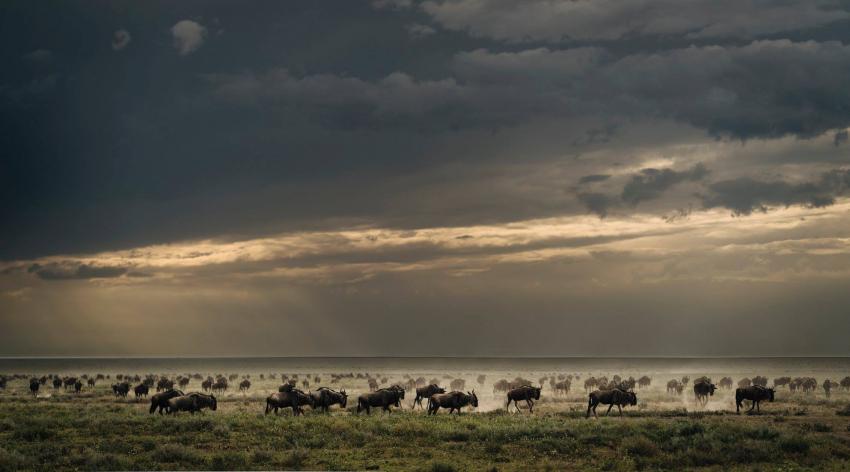Encompassing many of Tanzania’s must-see wildlife destinations, the Northern Circuit is undoubtedly one of the most visited regions in the country. It includes the iconic Serengeti National Park and the Ngorongoro Conservation Area, as well as the lesser-known Tarangire National Park and Lake Manyara National Park. Arusha National Park is another little-visited park at the gateway to the Northern Circuit near the safari capital of Arusha.
The Northern Circuit is a go-to option for first-time visitors to the country and for good reason. It boasts stunning landscapes, outstanding accommodation and exceptional wildlife viewing opportunities, including the annual Great Wildebeest Migration. To help plan the best safari in Africa, we’ve created this short guide to introduce some of the parks you can visit on the Northern Circuit and the best time to go.
Top spots to visit on the Northern Circuit
Serengeti National Park
Providing the backdrop to the Great Wildebeest Migration, the Serengeti National Park is one of Tanzania’s most iconic wildlife destinations. It encompasses more than 14,000 square kilometres of savannah, woodlands and riverine forests and is renowned for its high concentrations of big predators.

Aside from large numbers of lions, cheetahs and leopards, the Serengeti National Park is home to the “Big Five” and one of the best places to visit if you want to tick all off your list. There are also staggering numbers of wildebeest, zebras and gazelles during the annual migration season, not to mention hippos, impala and Masai giraffe. Vervet monkeys, olive baboons and black-and-white colobus also inhabit the lush forests along the Grumeti River while more than 500 species of birds have been recorded within the park.
The park also boasts some of East Africa’s most outstanding accommodation, including luxurious Serengeti lodges and seasonal camps where the wildlife action is right on your doorstep. Aside from daily game drives and guided walks, you can also experience its mesmerizing landscapes from the air during a once-in-a-lifetime hot air balloon safari.
Ngorongoro Conservation Area
Centred around the breathtakingly beautiful Ngorongoro Crater, this UNESCO World Heritage-listed conservation area is among Tanzania’s most photogenic landscapes. The crater walls act as a natural enclosure where not only the “Big 5” but also immense numbers of blue wildebeest, Grant's zebra and gazelles reside, together with wallowing hippos, spotted hyenas and East African wild dogs.

You can witness thousands of flamingos gathered in the shallows of Lake Magadi or head to the wildlife-rich Ndutu Lake area that’s renowned for its sightings of cheetahs and lions. There’s also exceptional bird watching in the Ngorongoro Highlands, with more than 500 species recorded, including numerous migratory species who venture here to refuel on their long journey from Asia and Europe.
Daily game drives are the main means of exploring the Ngorongoro Conservation Area, with a diverse choice of accommodation clustered along the crater rim. Aside from its wildlife plenty, the area is also home to the “Cradle of Mankind” at the Olduvai Gorge where one of the earliest known specimens of the human genus was discovered.
Tarangire National Park
Sprawling across lush river valleys, granite ridges and acacia woodlands, Tarangire National Park is one of the underrated gems of the Northern Circuit. It’s named after the Tarangire River that carves through its heart, providing a source of water for big game wildlife that includes thousands of wildebeest, zebras and antelopes. Up to 3,000 elephants have been recorded in Tarangire at any one time, not to mention giraffes, buffalos and Thompson’s gazelle. Leopards and cheetahs are also occasionally spotted, as are generic and oryx.

But one of the biggest appeals of the Tarangire National Park is the reduced crowds when compared to the Serengeti National Park and Ngorongoro Conservation Area, making it ideal for an off-the-beaten-track experience. Rather than jostling with other jeeps for the best viewing angle, you can enjoy a much quieter atmosphere and intimate wildlife encounters.
Aside from daily game drives, walking safaris are also popular in Tarangire National Park for getting up close to wildlife without the hum of a jeep engine. It’s also possible to embark on an overnight fly-camping adventure for an incredible evening beneath the never-ending African sky.
Lake Manyara National Park
It might be small in size but Lake Manyara National Park is among the most stunning wildlife destinations on the continent and was described by Ernest Hemingway as “the loveliest I had seen in Africa”. It stretches for around 50 kilometres along the base of the Rift Valley escarpment, encompassing evergreen forest, savannah and marshlands around it centrepiece soda lake.

Lake Manyara National Park features one of the highest biomass densities of large mammals in the world, with compact game-viewing experiences. Aside from large families of elephants and unique tree-climbing lions, it’s home to Masai giraffe, wildebeest and zebra, not to mention buffalo, gazelles and hippos that can be seen submerging themselves in the lake waters. But perhaps the most famous experience at Lake Manyara is witnessing the thousands of flamingos that cluster along the lake’s shores during the wet season. More than 400 species of birds have been recorded within the park’s boundaries while blue monkeys and baboons also inhabit the forests.
Thanks to its compact size, you can explore Lake Manyara is as little as a few hours on game drives. But it’s worth staying a couple of days to experience a night safari to encounter some of Lake Manyara’s nocturnal species, complemented by an unforgettable bush dinner under the stars on a Tanzania safari package.
Arusha National Park
Dominated by the peak of Mount Meru, Arusha is a small but impressive national park that often serves as an introduction to visitors embarking along the Northern Circuit. Its proximity to the safari capital of Arusha makes it an easy day trip, with landscapes that vary from lush highland forests to the grasslands surrounding the Ngurdoto Crater and the shallow alkaline Momella Lakes.

Arusha National Park is home to a rich variety of wildlife, including giraffe, Cape buffalo and zebras. Black-and-white colobus monkeys and blue monkeys also inhabit the forests while flamingos can often be seen wading in the lake waters. A prolific birdlife is a highlight of the park (with special sightings of Narina trogon and bar-tailed trogon) while Mount Meru is a hiking destination in its own right, with spectacular views of neighbouring Mount Kilimanjaro.
Best time to visit
The dry season from June to October is generally considered the best time to visit the Northern Circuit on a private safari in Tanzania, with the thinner vegetation and limited water sources making wildlife easier to spot. Sunny skies and little rainfall mean it’s ideal for being out and about on game drives, with fewer mosquitoes around the camps and lodges in the evenings.
If you want to see the wildebeest migration in full swing, then June and July are the best times for a luxury safari in Tanzania on the Northern Circuit, although you can expect large crowds in the Serengeti and Ngorongoro (and higher accommodation prices as a result). This is the best time to visit if you want to see the wildebeest crossing the Grumeti River or you can plan your trip for August to experience the famous Mara River crossing.
November through to May is the wet season across Northern Tanzania, with the grassy plains turning a lush and photogenic green. The short, afternoon showers shouldn’t interfere with your travel plans across the region, however, and you’ll be treated to stunning bird watching as migratory birds flock from Europe and Asia.

 1-321-766-6821
1-321-766-6821 







